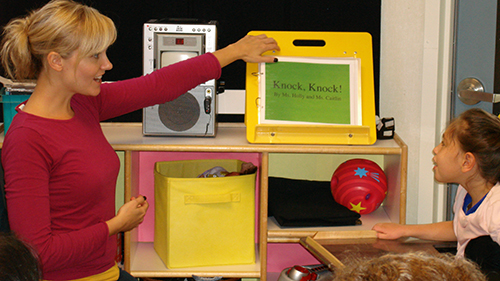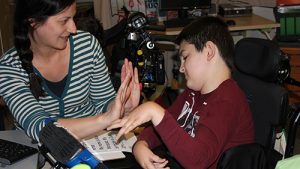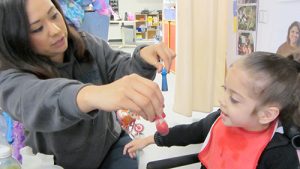Interaction Strategies
“Interactions are experienced mutually by communication partners and both parties are affected reciprocally” (Siegel & Cress, 2002)
The Bridge School staff understands that “It is conversations that are impaired, not the interactants” (Wilkins, 2004). As a result, we always teach our students, staff and family members useful strategies to support successful interactions within and outside the educational environment. The importance of including the family in this process is critical. Research has shown that effective parent/caregiver training strategies result in positive learning outcomes outside of school (Kent-Walsh, J. & Binger, C., & Hasham, Z. 2010; Warren, Yoder, & Leew 2002; Yoder & Warren 2001; Yoder & Warren 1998).
Below are descriptions of ways for partners to increase responsivity to create communication opportunities, modify pacing of instruction, use modeling, provide meaningful language input and promote parity.
Students require repeated practice in naturalistic contexts with multiple partners in order to build communicative competence skills (Blackstone, 2008). Educators use a variety of practices and procedures to create frequent and motivating communication opportunities. Many of these strategies come from enhanced milieu teaching, which focuses on embedding communication opportunities within typical classroom activities by following the child’s attentional lead, interacting responsively and arranging the environment to increase student engagement.
Following the child’s lead
Following the child’s lead is a technique where the adult observes the child and identifies what their attention is focused on and/or what they are interested in, and then engages with the child around the student’s interest. The focus is on having the student lead the interaction with the adult joining in and talking about objects, events and relations that have attracted the child’s attention.
Arranging the environment
Arranging the environment involves the selection and use of materials, layout of the physical space and the structure of activities and routines. Providing interesting materials that encourage social and interactive play and cooperation can naturally create communication opportunities. Identifying preferred materials and activities and providing them to students can increase levels of engagement and create reasons for students to communicate for a range of purposes (e.g., requesting a favorite toy). Providing play and learning areas that accommodate small groups can create peer proximity that encourages social interactions between students. Establishing routines for repeated activities in regular locations can help students learn to anticipate upcoming activities based upon where they are in the classroom.
Commenting and asking questions
Commenting and asking questions encourages children to talk about their actions and express their feelings and opinions. Commenting on student activities demonstrates adult interest and engagement in what the student is doing and what he or she cares about. Open-ended questions are those questions that do not dictate a specific form in the response (e.g., “Tell me about…” or “Now what?”). Open-ended questions have a variety of possible answers. In contrast, closed-set or test questions dictate a specific answer from a set of options and are not as supportive to language and communication development as open-ended questions. Wh-questions (e.g., Who, What, Where, Why) contain a specific “question word” and thus elicit a response to match the type of question asked.
Offering choices
Offering choices between at least two different options is an easy and effective technique to provide students with opportunities to express their preferences and learn to make requests. Offering numerous choices during interactions can establish and extend student engagement in activities as well as promote self-determination skills. In an elicited offered choice, the adult initiates an interaction (e.g., by asking “What do you want?”) and offers two or more clearly-defined options and the student responds to indicate their desired choice (Sigafoos and Mirenda, 2002). A binary choice is a choice between two items or options.
Blocked response/interrupted behavior chain
Blocked response/interrupted behavior chain occurs when the adult interrupts a student’s on-going activity such that a need for communicating a request is created (e.g., preventing a student from moving towards the ball, creating a need for the student to request to play more).
Sabotage
Sabotage (also known as missing item format) occurs when the adult provides materials that are difficult to operate or provides inadequate portions of desired or needed materials, such that the student is motivated to communicate to request assistance or request a needed item.
Communicative temptations
Communicative temptations involve setting up situations in which the student is likely to be motivated to communicate (Iacono, et al, 1998). Examples of this technique include: activating a wind-up toy, letting it de-activate, and then placing it in front of the child; eating a food item in front of the student without offering any; and initiating a familiar or unfamiliar social game with the student until he or she expresses pleasure, then stopping the game and waiting for a communication signal.
Physical Proximity
Physical Proximity refers to when a partner adjusts their physical closeness to a student during an interaction. Close proximity can be used to let the student know you are nearby and ready for them to initiate an interaction and proximity helps maintain active engagement during the interaction. In this strategy, a communication partner will get close enough to a student so they are in the student’s best visual field, while still maintaining personal space (a comfortable distance away from one’s partner). Appropriate proximity helps beginning communicators focus on their communication partner and remain more engaged in the exchange rather than becoming distracted by other stimuli.
Pacing refers to anything the partner does to alter the timing of the interaction to allow the student with complex communication needs (CCN) to participate, practice a target skill or access the materials. This can be something as simple as providing enough response time for a student to compose their message during an interaction. Students who use AAC tools and techniques may need increased response time to express their desired intent, especially when learning a new mode of expression, learning a new communicative function or learning a new operational skill.
Partners who are unaccustomed to interacting with someone who uses AAC may need to be taught to adjust their conversational pace and observe the student to know when they are trying to enter into the conversation (Blackstone 2008). Allowing 5 seconds of silence after speaking can signal to the student an opportunity to respond. Appropriate pacing is particularly important for beginning communicators who are just learning how their actions are interpreted by others.
At The Bridge School, partners (professionals, instructional assistants, parents, peers, etc.) learn to wait and watch during play or conversation with emergent communicators, to observe and reinforce intentional and communicative behaviors.
Time delay
Time delay is a specific pacing procedure where the adult intentionally waits expectantly when the student shows an interest in something, rather than using a specific prompt or model. In this instance, the natural context serves as the cue for the child to communicate. A time delay sequence has several steps: 1) face the child with an expectant facial expression while showing something of interest to the student or something that gains the child access to a desired activity, 2) establish and maintain eye contact and wait a specified time period for the child to initiate a communicative bid, 3) if the child does not initiate within the time frame, model the desired communication behavior and then wait, 4) if the child responds appropriately, provide the desired item while praising the child and providing a label and an expansion of his or her production 5) if the response is incorrect, provide a corrective model (e.g., say “more”) and then give the child the item or access to an activity.
Waiting
Waiting is a simple and effective strategy where the adult uses a slower pace during conversation, actively listens to the child and does not dominate the interaction. The adult waits to see what behaviors the child produces and then responds.
Pausing
Pausing is another technique where the adult changes the rate of spoken input to the child. The adult can pause expectantly during interactions, either before, during or after providing language input. Adding pauses in the adult’s speech while looking at the child (and or the object of interest) with raised eyebrows and a smile encourages the child to take communicative turns and actively participate in interactions of increasing length. This is also known as expectant delay.
Modeling is a central procedure in milieu and enhanced milieu teaching. Milieu teaching takes place in naturalistic contexts, makes use of the student’s interests and encompasses several evidence-based strategies for promoting development in language, communication, social, cognitive, motor and adaptive skills (Warren, Yoder, & Leew 2002; Kaiser 2012). In the modeling procedure, the adult follows the child’s focus/attention and provides a model that is contingent, or in response to, the student’s communicative act or intention. For our students learning to use AAC, the adult models using the target AACmode or tool for each student as well as a spoken model. Modeling using the student’s own AAC tools has been shown to be an effective teaching strategy (Binger and Light 2007). For example, if a preschool student playing in the pretend play center indicates the baby doll toy (through eye gaze, ambulating to the location, nonspecific vocalization, etc.), the adult would then say “tell me baby” and provide a model by pointing to the child’s low-tech board, accessing their SGD using the student’s access method or producing a sign or gesture (whatever the goal is for that particular student). The adult then waits expectantly for the student to imitate the model. Imitation is followed by praise and immediate access to the desired item.
Mand-Model
Once students are able to reliably imitate models, interventionists can use another milieu strategy called mand-model. In this procedure, a mand or request is provided first (e.g., “what do you want?” or “tell me”) to see if the student can demonstrate the target skill without a model, and a model is provided only if necessary.
Language Input strategies refer to ways the adult’s responses can enhance the student’s communicative skills and language development. The goal of these responsive interaction interventions is to teach partners to provide rich language stimulation contingent to the child’s communicative productions (McCormick, 2003). Contingent responses are those that immediately follow a child’s behavior and relate directly to the child’s communicative behavior. Highly responsive adult input to children demonstrating pre-intentional communication behaviors can support a child as they learn to use intentional communication behaviors (Harwood, Warren and Yoder, 2002). It is important to note that the goal of responsive teaching is not to elicit or prompt specific behaviors from the student, but rather for the adult partner to provide rich language input. Research shows that it can be particularly effective to teach these responsive strategies to parents and caregivers (e.g., Warren, Yoder, and Leew, 2002; Yoder & Warren, 1998, 2001). Language input techniques include imitations, recasts, extensions, labels, confirmations, and augmented communicative input.
Imitations
Imitations are simply the adult imitating the student’s communicative act to reinforce the behavior. For students using AACstrategies, the adult may imitate a gesture, vocalization, or other body-based mode and reinforce the behavior’s meaning by providing a natural consequence that shows that the student’s intended message was understood. When students use SGDs to communicate, adults can verbally imitate or repeat the student’s message output. Communication partners can also imitate student actions (e.g., waving hands, reaching towards an object of interest, etc.) during interactions to extend the interaction and promote reciprocity.
Recasts
Recasts are imitations that add new information. For example, a student may use his SGD to say “walker recess” when it’s time to go outside for recess. The adult can expand or recast this message and say something like “yes, it’s time to get in your walker and go outside for recess”. If appropriate for the student and the context, the adult may use the student’s SGD to provide a recast that is within the student’s ability to compose. In the example above, this might look like using the AAC device to say “I want” + “walker” or “time for” + “recess.” Gestures and body-based communicative acts can also be recast by the adult adding more unaided information (e.g., another gesture), or adding augmented input (e.g., imitating gesture and pointing to a low-tech board). Recasts preserve the student’s intended meaning but add grammatical information, and they do not disrupt the flow of communication (Bunce, 2008).
Labeling
Labeling is a simple technique where the adult describes the actions, people, activities, and places in the student’s environment. Adults can provide the names of familiar and unfamiliar objects, as well as emotions and relational concepts.
Confirming
Confirming occurs when the adult responds to all communicative bids by verbally confirming understanding of the child’s perceived intentions. The adult does not ignore the child’s attempts at interaction, regardless of the communicative modality used by the child.
Augmentative Communication Input
Augmentative Communication Input refers to providing models and input using the student’s own aided AAC system. It is important for students with CCN to have rich spoken language input as well as competent models of how, when, and why to use SGDs, low-tech tools, or unaided modes (Sevcik and Romski, 2002).
Aided Language Stimulation
Aided Language Stimulation is a commonly referred to augmented input procedure where the adult provides ongoing spoken language input in conjunction with aided input, such as pointing to the student’s low-tech board or accessing their SGD.
Promoting parity refers to maintaining balance between the partners in a communicative exchange. Often, students with complex communication needs (CCN) fall into a passive role where things are done to them, for them and around them. Maintaining active engagement from a student with CCN requires keen observation from the partner, along with modified pacing of the interaction. The partner must be actively engaged in the conversation or activity, and also continually “check in” with the student’s engagement. This involves simple preparatory statements such as “are you ready?”, “shall we begin?”, “how does that sound?”, etc.; and monitoring for responses from the student. These responses are typically quick and body-based or gestural (vocalizing, nodding or shaking head, looking towards materials, etc.). In this manner, over time students learn to take on a more active role in interactions and demonstrate their engagement to partners.
References
Binger, C. & Light, J. (2007). The effect of aided AAC modeling on the expression of multi-symbol messages by preschoolers who use AAC. Augmentative and Alternative Communication, 23(1), 30-43.
Blackstone, S. (2008). Principles for classrooms with students who use AAC. Augmentative Communication News, 20(4).
Bunce, B.H. (2008). Early literacy in action: The language-focused curriculum for preschool. Baltimore: Paul H. Brookes Publishing Co.
Girolametto, L., Weitzman, E., & Greenberg, J. (2003). Training day care staff to facilitate children’s language. Am J Speech Lang Pathol, 12(3), 299-311.
Iacono, T., Carter, M., & Hook, J. (1998). Identification of intentional communication in students with severe and multiple disabilities. Augmentative and Alternative Communication, 12, 102-114.
Justice, L. M. (2004). Creating language-rich preschool classroom environments. Teaching Exceptional Children, 37(2), 36-45.
Kaiser, A.P. (2012). Enhanced milieu teaching: Incorporating AAC modes in naturalistic teaching with young children and their partners. Partner Instruction in AAC. ASHA Online Conference, June 13-25, 2012.
Kent-Walsh, J. & Binger, C., & Hasham, Z. (2010). Effects of parent instruction on the symbolic communication of children using augmentative and alternative communication during storybook reading. American Journal of Speech-Language Pathology (19), 97-107.
Kent-Walsh, J. & Binger, C. (2009). Addressing the communication demands of the classroom for beginning communicators and early language users. In Practically speaking: Language, literacy, & academic development for students with AAC needs. Soto, G. & Zangari, C. (Eds.). Baltimore: Paul H. Brookes Publishing Co.
McCormick, L. (2003). Language intervention in the inclusive preschool. In Supporting children with communication difficulties in inclusive settings: School-based language intervention. 2nd edition. McCormick, L., Loeb, D.F., Schiefelbusch, R.L. (Eds.). Boston: Allyn and Bacon.
Reichle, J., Hidecker, M.J.C., Brady, N.C., & Terry, N. (2003). Intervention strategies for communication: Using aided augmentative communication systems. In Communicative competence for individuals who use AAC: From research to effective practice. Light, J.C., Beukelman, D.R., & Reichle, J. (Eds.). Baltimore: Paul H. Brookes Publishing Co.
Sevcik, R.A. & Romski, M.A. (2002). The role of language comprehension in establishing early augmented conversations. In Exemplary practices for beginning communicators: Implications for AAC. Reichle, J., Beukelman, D.R. & Light, J.C. (Eds.). Baltimore: Paul H. Brookes Publishing Co.
Siegel, E.B. & Cress, C.J. (2002). Overview of the Emergence of Early AAC Behaviors. In Exemplary Practices for Beginning Communicators: Implications for AAC.Reichle, J., Beukelman, D.R. & Light, J.C. (Eds). Baltimore: Paul H. Brookes Publishing Co.
Warren, S.F., Yoder, P.J., & Leew, S.V. (2002). Promoting social-communicative development in infants and toddlers. In Promoting social communication: Children with developmental disabilities from birth to adolescence. Goldstein, H., Kaczmarek, L.A., & English, K. (Eds.). Baltimore: Paul H. Brookes Publishing Co.
Yoder, P. J. & Warren, S. F. (1998). Maternal responsivity predicts the prelinguistic communication intervention that facilitates generalized intentional communication. J Speech Lang Hear Res, 41(5), 1207-1219.
Yoder, P. J. & Warren, S. F. (2001). Relative treatment effects of two prelinguistic communication interventions on language development in toddlers with developmental delays vary by maternal characteristics. J Speech Lang Hear Res, 44(1), 224-237.




